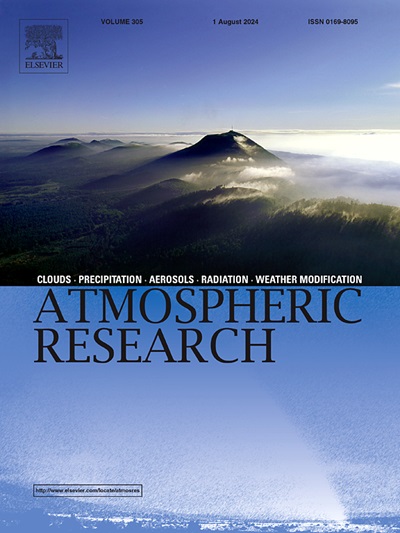利用 3D-Var 对多源观测数据进行同化对模拟印度卡纳塔克邦极端降雨事件的相对影响
IF 4.4
2区 地球科学
Q1 METEOROLOGY & ATMOSPHERIC SCIENCES
引用次数: 0
摘要
本研究采用三维变分(3D-Var)同化方法,探讨了同化多种观测数据对极端降雨事件(EREs)预报的影响。研究使用具有三个嵌套域的高分辨率(03 公里)天气研究与预报(WRF)模型,重点研究了印度卡纳塔克邦三个气象分区的 38 次极端降雨事件。共进行了五次不同的实验,包括一次不进行同化的对照实验,以及整合了各种来源观测数据的后续实验,如大气红外探测器(AIRS)、中分辨率成像分光仪(MODIS)卫星和无线电探空仪的大气剖面图、高级散射计(ASCAT)、特殊传感器微波成像仪(SSMI)、WindSAT 卫星和浮标的海面风观测数据,卡纳塔克邦自然灾害监测中心(KSNDMC)的地面观测数据,以及所有可用观测数据的综合同化试验。通过将模型输出与高分辨率遥测雨量计(TRG;6480 个站点)数据和其他气象参数与卡纳塔克邦自然灾害监测中心的遥测气象站(TWS;860 个站点)数据进行比较,评估了降雨预报的准确性。与对照实验相比,同化实验在预测降雨量方面取得了积极进展。结果一致表明,在所有实验中,对地形复杂的西高止山脉(WG)地区的降雨预测不足,而对卡纳塔克邦沿海地区的降雨预测则偏高。海洋风实验显示,降雨预测过高(超过 2 毫米临界值)的情况大幅减少了 40%。在卡纳塔克邦的大部分地区,海洋风和站点数据同化都显著提高了降雨预测精度,其中海洋风的提高幅度最大(53%),紧随其后的是站点数据(50%)。重要的是,与对照实验相比,海洋风和站点数据同化有助于减少过高预测,而卫星剖面同化则减少了卡纳塔克邦内陆地区的过低预测,但增加了沿海地区的过高预测。在所有 3D-Var 试验中,沿海岸线的降雨发生频率都大大提高。偏差分值表明,使用海洋风和站点数据进行同化时,偏差分值得到了最大程度的改善。基本气象参数的模拟也在同化后得到改善,尤其是在白天。这些结果表明,在季风季节,卫星和现场观测数据的同化在提高EREs预报精度方面起着至关重要的作用。本文章由计算机程序翻译,如有差异,请以英文原文为准。
Relative Impact of Assimilation of Multi-Source Observations using 3D-Var on Simulation of Extreme Rainfall Events over Karnataka, India
This study explores the impact of assimilating diverse observational data on forecasting extreme rainfall events (EREs) using a three dimensional variational (3D-Var) assimilation approach. It focuses on 38 EREs across three meteorological divisions in Karnataka, India, using a high-resolution (03-km) Weather Research and Forecasting (WRF) model with three nested domains. Five distinct experiments were conducted, including a Control experiment without assimilation, and subsequent experiments integrating observations from various sources like atmospheric profiles from Atmospheric InfraRed Sounder (AIRS) and Moderate resolution Imaging Spectroradiometer (MODIS) satellites and radiosondes, ocean surface wind observations from Advanced Scatterometer (ASCAT), Special Sensor Microwave Imager (SSMI), and WindSAT satellites and buoys, ground observations from Karnataka State Natural Disaster Monitoring Centre (KSNDMC), as well as a combined assimilation experiment with all available observations. The accuracy of rainfall forecasts is evaluated by comparing model outputs with high-resolution telemetric rain-gauge (TRG; 6480 stations) data and other meteorological parameters against telemetric weather station (TWS; 860 stations) data from KSNDMC. Assimilation experiments show positive improvements over control experiment in predicting rainfall. Results consistently indicate underprediction of rainfall in the intricate topographical region of the Western Ghats (WG) across all experiments, contrasting with overprediction along the coastal areas of Karnataka. The experiment involving Ocean Winds showcased a substantial 40 % reduction in rainfall overprediction (above 2 mm threshold). Both Ocean Winds and Station Data assimilation notably enhanced rainfall prediction accuracy over most of the regions in Karnataka, with Ocean Winds exhibiting the highest improvement (53 %), closely followed by Station Data (50 %). Importantly, assimilating Ocean Winds and Station Data aided in reducing overprediction, while assimilating Satellite Profiles reduced underprediction in the interior part of Karnataka but increased overprediction over the coastal region compared to the control experiment. Frequency of occurrence of rainfall is considerably enhanced along the coastline in all 3D-Var experiments. Bias score indicates maximum improvement in assimilation using Ocean Winds and Station Data. Simulation of basic meteorological parameters also improved with assimilation particularly during the day hours. The results underscore the crucial role of assimilation of satellite and in-situ observations in improving forecast accuracy of EREs during the monsoon season.
求助全文
通过发布文献求助,成功后即可免费获取论文全文。
去求助
来源期刊

Atmospheric Research
地学-气象与大气科学
CiteScore
9.40
自引率
10.90%
发文量
460
审稿时长
47 days
期刊介绍:
The journal publishes scientific papers (research papers, review articles, letters and notes) dealing with the part of the atmosphere where meteorological events occur. Attention is given to all processes extending from the earth surface to the tropopause, but special emphasis continues to be devoted to the physics of clouds, mesoscale meteorology and air pollution, i.e. atmospheric aerosols; microphysical processes; cloud dynamics and thermodynamics; numerical simulation, climatology, climate change and weather modification.
 求助内容:
求助内容: 应助结果提醒方式:
应助结果提醒方式:


